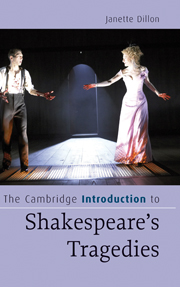Book contents
- Frontmatter
- Contents
- Acknowledgements
- Introduction
- Chapter 1 Tragedy before Shakespeare
- Chapter 2 Titus Andronicus
- Chapter 3 Romeo and Juliet
- Chapter 4 Julius Caesar
- Chapter 5 Hamlet
- Chapter 6 Othello
- Chapter 7 Timon of Athens
- Chapter 8 King Lear
- Chapter 9 Macbeth
- Chapter 10 Antony and Cleopatra
- Chapter 11 Coriolanus
- Notes
- Index
Chapter 3 - Romeo and Juliet
Published online by Cambridge University Press: 05 August 2015
- Frontmatter
- Contents
- Acknowledgements
- Introduction
- Chapter 1 Tragedy before Shakespeare
- Chapter 2 Titus Andronicus
- Chapter 3 Romeo and Juliet
- Chapter 4 Julius Caesar
- Chapter 5 Hamlet
- Chapter 6 Othello
- Chapter 7 Timon of Athens
- Chapter 8 King Lear
- Chapter 9 Macbeth
- Chapter 10 Antony and Cleopatra
- Chapter 11 Coriolanus
- Notes
- Index
Summary
By the time Shakespeare came to write Romeo and Juliet, around 1595, he was a sharer with the Lord Chamberlain's Men, established as one of two companies licensed to play in London between 1594 and 1600. He was to write for this company, which became the King's Men when James VI and I came to the English throne in 1603, for the rest of his working life, writing on average two plays a year for them. The Rose, where Titus Andronicus was produced, was to become the resident playhouse of the other premier playing company in England, the Admiral's Men, while the Chamberlain's Men, up to 1599, played first at the Theatre (until April 1597) and then at the Curtain, both in Shoreditch. Romeo and Juliet could have been produced in one or both of these playhouses.
This tragedy could scarcely be more different from Titus Andronicus. It is also very different both from any of Shakespeare's other tragedies and, in its totality, from anything that has gone before it on the English stage, though various influences are visible, including those of Marlowe and Lyly, the most notable writer of plays centring on romantic love before Shakespeare. Lyly, however, was a writer of comedy; and many critics have noted the way Romeo and Juliet feels more like a comedy that just misses resolution than a tragedy. In both subject matter and structure it resembles Shakespeare's comedies of the 1590s, like The Merchant of Venice (1596–7) and Much Ado About Nothing (1598), where tragedy seems close but is averted. Its strongly lyrical mode, however, is reminiscent of the non-dramatic poetry Shakespeare was writing in the earlier 1590s (Venus and Adonis (1592–3) and The Rape of Lucrece (1593–4)) and also of the tragic history of Richard II (1595).
- Type
- Chapter
- Information
- The Cambridge Introduction to Shakespeare's Tragedies , pp. 40 - 51Publisher: Cambridge University PressPrint publication year: 2007

